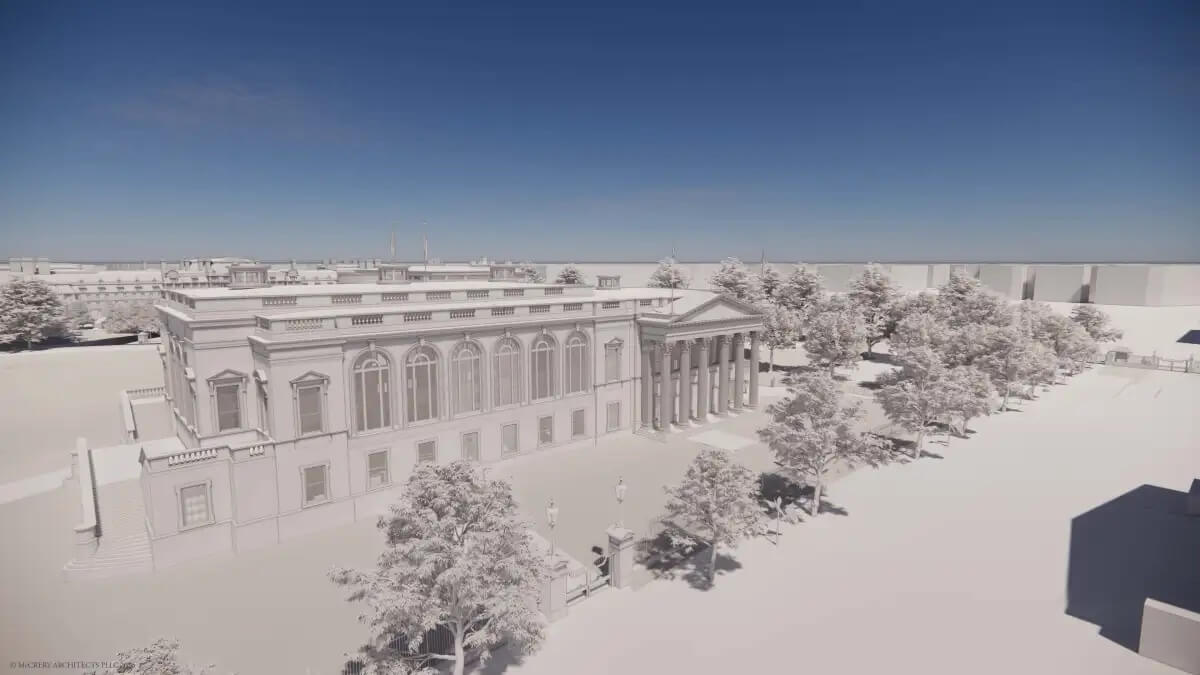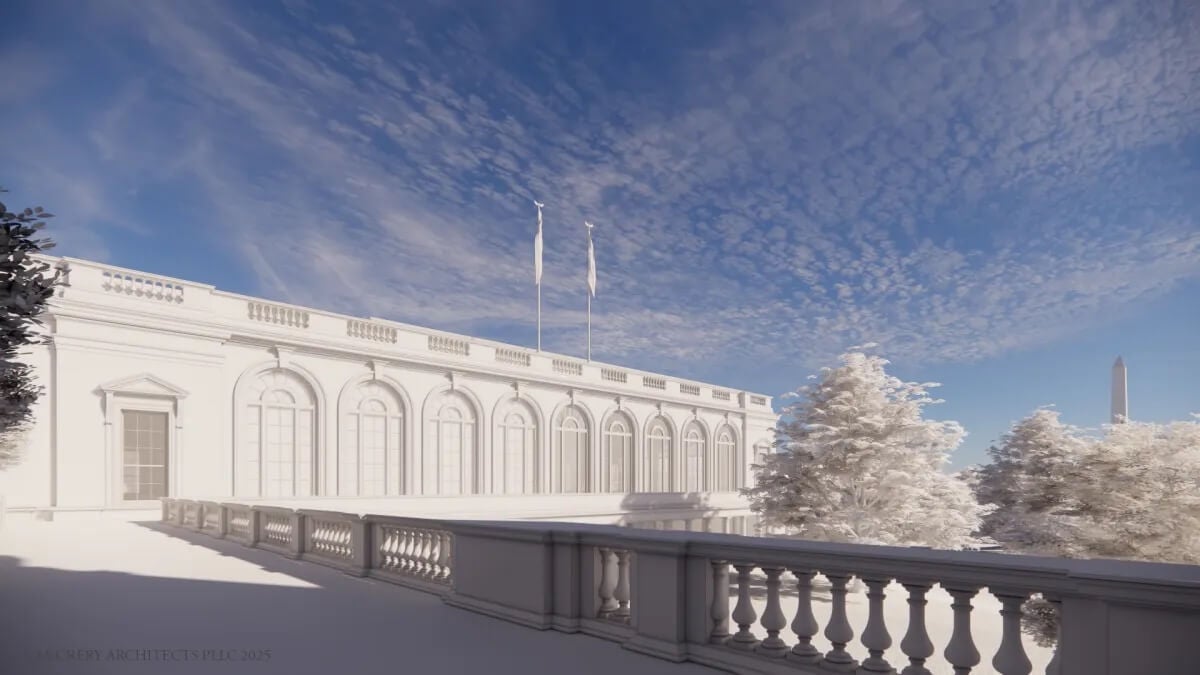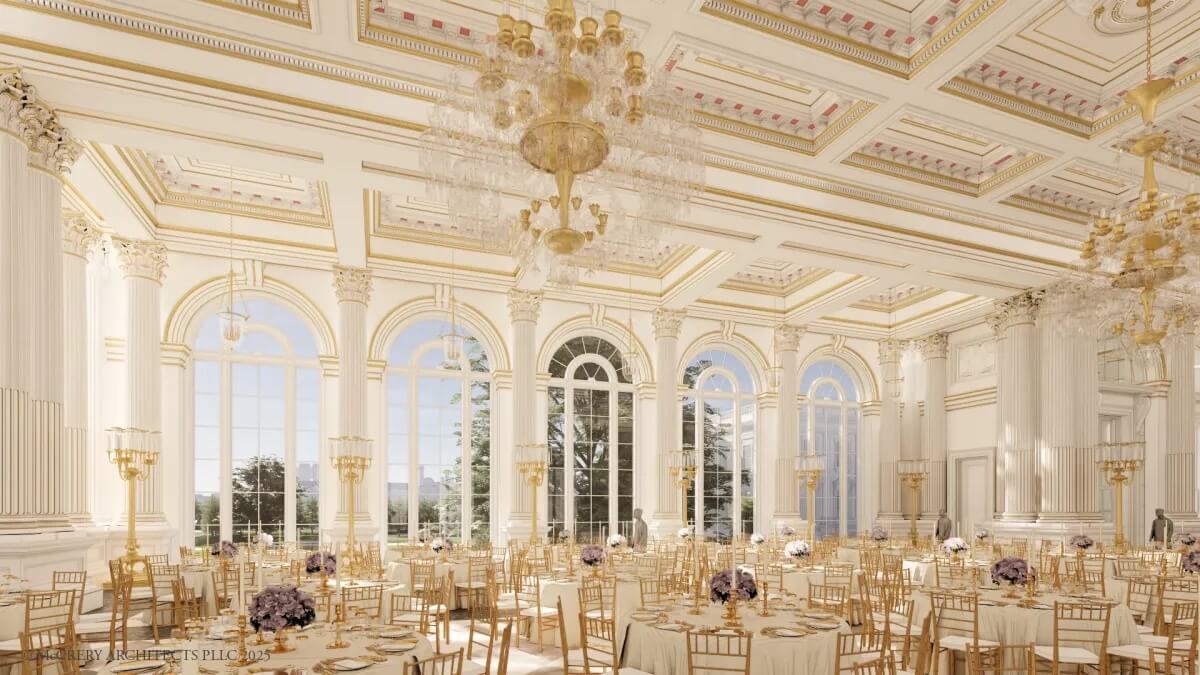As President, Donald Trump has found myriad ways to keep his “real-estate juices flowing.” The builder-minded developer-turned-politician has pivoted his attention from luxury hotel towers and country clubs to set his sights on his current digs: the White House. Since taking office in January, Trump has redecorated the Oval Office and is paving over the Rose Garden. This week he confirmed plans to expand the White House’s event space with a big, beautiful ballroom designed in a classical style.
McCrery Architects, a Washington, D.C.–based firm led by Jim McCrery designed the addition. AECOM will provide the engineering, and Clark Construction will realize the building.
McCrery has specialized in cathedrals and Catholic churches. He is outspoken about his reverence for classical and “traditional” design, not unlike Trump. McCrery is also an associate professor within the School of Architecture and Planning at The Catholic University of America, where he is known on campus for his “stylish bow-ties.”
McCrery’s biography on the school’s website states that he earned two architecture degrees at Ohio State University before working in the New York office of Peter Eisenman, who was also McCrery’s professor during his graduate degree, along with Jeffrey Kipnis. This work experience led McCrery to rethink “his modernist education.” Later, “the philosophical foundations of Post-Modern thought and its implications for architecture led Mr. McCrery to investigate and ultimately commit to Classical Architecture.” He then found work with classical architect Allan Greenberg. The shift from modern to postmodern to classical theory was ridiculed by the satirical anonymous Instagram account @b0ysfirm in a recent post.
From 2019 until 2024, McCrery served on the U.S. Commission of Fine Arts. He was appointed by President Trump during his first term in office.
A New Pitch
In an announcement, the White House said the impetus for a new ballroom stems from a longing for “a large event space on the White House complex.” The administration is seemingly fed up with having to pitch a tent on the lawn when hosting larger state dinners. Trump had the idea in mind well before his first term: In 2010 he called then-President Barack Obama offering to build an event space, but received no response.
The ballroom structure will be the first structural change to executive residence since the addition of the Truman balcony in 1948. McCrery’s design will realize a 90,000-square-foot ballroom “substantially separated from” the White House’s East Wing. The new space will be designed to accommodate 650 people seated, more than the East Room’s current 200-person capacity. With a price tag of $200 million, the rough math for cost is $2,222 per square foot of new construction.
“It’ll be near it but not touching it and pays total respect to the existing building, which I’m the biggest fan of,” Trump said of the White House. “It’s my favorite. It’s my favorite place. I love it.”
To appease Trump’s flashy, “dictator chic” taste—and any cries from preservationists on edge about work on historic buildings and sites—rest assured, the White House said the “theme and architectural heritage will be almost identical.” Press Secretary Karoline Leavitt confirmed that “nothing will be torn down” to erect the new structure. She added that renovations and upgrades will also be made to the East Wing.

Renderings shared of the ballroom addition reveal a Palladian structure lined with Corinthian columns and rows of Venetian windows. Inside, a coffered ceiling will be adorned with glimmering gold accents. Large chandeliers and other massive candelabras will illuminate the interiors, which are largely finished in white paint.
The two exterior renderings appear rushed: The two distributed images are not mapped with materials and read as “arctic mode”–style outputs using default settings, including a sky that is all too familiar to architects who use softwares like Enscape to create architectural renderings. In one, some of the glass windows are rendered as opaque, not transparent, and the American flag is shown rendered in white, not in its accurate coloration. No drawings have been published that show the placement of the new structure as it relates to the existing White House.
For the Love of Money
“Presidents in the modern era have faced challenges hosting major events at the White House because it has been untouched since President Harry Truman,” architect Jim McCrery said in a statement. “I am honored that President Trump has entrusted me to help bring this beautiful and necessary renovation to The People’s House, while preserving the elegance of its classical design and historical importance.”
McCrery is also a cofounder of the National Civic Art Society (NCAS) and a member of the nonprofit’s Board of Directors. NCAS President Justin Shubow, said in a statement, “Our organization has no doubt he’ll design a beautiful, fitting addition. It was President Theodore Roosevelt who personally chose Beaux-Arts architect Charles McKim to renovate the White House in his time. President Trump has made an equally wise decision in hiring McCrery.”

In the weeks leading up to the announcement and design reveal, President Trump stepped back into the role of real estate mogul planning the design alongside White House Staff, the National Park Service, and the White House Military Office. The United States Secret Service has also been involved in the project’s planning.
As any developer knows, once you’ve found your land, then you’ve then got to find the money. The White House said Trump and “other patriot donors” will shell out the money for the ballroom. Congressman Mark Pocan, a Democrat from Wisconsin, raised questions about this funding structure, and asked whether it should be brought up for discussion with Congress.

A further question is the procurement process: Other additions to Washington, D.C., like monuments, museum expansions, and renovations often go through competitions or RFP/RFQ proposals to select the best designs or teams to contribute to the city’s built environment.
Construction will begin in September 2025 and will wrap up “long before” the end of Trump’s term, according to the White House.
“I’m good at building things and we’re going to build quickly and on time. It’ll be beautiful, top, top of the line,” Trump said.
→ Continue reading at The Architect's Newspaper
